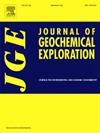阿比提比次省普雷萨克-拉科恩岩浆岩地区拉莫特伟晶岩的特征及其对勘探的影响
IF 3.3
2区 地球科学
Q1 GEOCHEMISTRY & GEOPHYSICS
引用次数: 0
摘要
该项目重点研究阿比提比省 La Motte Batholith (LMB) 地区伟晶岩的特征,该地区位于鲁昂-诺兰达市(Rouyn-Noranda)和瓦尔道尔市(Val d'Or)之间,距离北美锂矿(1.019 亿吨 @ 1.06 % Li2O; Sayona Québec)以西约 30 公里。该研究区域拥有关键性和战略性矿产,其中最著名的是Authier矿床,这些矿床只与Li-Cs-Ta伟晶岩有关。研究的目的是描述该地区伟晶岩的矿物学和地球化学特性,以便更好地确定锂勘探目标。这种特征描述有助于细分锂辉石矿区的伟晶岩家族,从贫瘠的荚状伟晶岩到富含磷灰石的岩体。在 LMB 区内,伟晶岩面显示出与相交伟晶岩堤相似的化学特征,这表明 La Motte 浴岩单斜岩与不同伟晶岩系列之间存在遗传联系,尽管其年龄可能相差几百万年。研究结果还证实,与其他岩脉相比,无论在同一岩脉中的哪个取样位置,含锂岩脉中的全岩分析元素比率(K/Rb、K/Cs、Nb/Ta、Mg/Li 和 Zr/Hf)都显示出最低值。来自不同伟晶岩的钾长石和麝香石微探针分析也显示出与全岩分析相似的 K/Rb 和 K/Cs 比率,从而加强了对 LMB 伟晶岩分馏程度的评估。因此,即使在尚未发现闪长岩的地方,也可以通过这些比率来确定高度分馏岩体的所在区域。本文章由计算机程序翻译,如有差异,请以英文原文为准。
Characterization of pegmatites in the La Motte Batholith area, Preissac-La Corne Plutonic Suite, Abitibi Subprovince and its implications for exploration
This project focuses on the study of pegmatite characteristics in the La Motte Batholith (LMB) sector in the Abitibi Subprovince, located between the cities of Rouyn-Noranda and Val d'Or, and approximately 30 km west of the North American Lithium mine (101.9 Mt @ 1.06 % Li2O; Sayona Québec). The study area hosts mineralizations in critical and strategic minerals, most notably the Authier deposit, which are exclusively associated with Li-Cs-Ta pegmatites. The aim of the study is to characterize the mineralogical and geochemical properties of the pegmatites in the sector to better target lithium exploration. This characterization enables the subdivision of various families of pegmatites in the LMB sector, ranging from barren pods to spodumene-rich dykes. Within the LMB, the pegmatitic facies exhibit chemical characteristics similar to those of intersecting pegmatite dykes, suggesting a genetic link between the La Motte Batholith monzogranite and the different pegmatite families despite a possible age difference of several million years. The results also confirm that elemental ratios from whole-rock analyses (K/Rb, K/Cs, Nb/Ta, Mg/Li, and Zr/Hf) within lithium-bearing dykes show the lowest values compared to other dykes, regardless of the sampling location within the same dyke. Potassium feldspar and muscovite microprobe analyses from different pegmatites also reveal K/Rb and K/Cs ratios similar to whole-rock analyses, thereby strengthening the assessment of the fractionation degree of the LMB pegmatites. These ratios thus allow for targeting sectors hosting highly fractionated dykes even where spodumene has not yet been identified.
求助全文
通过发布文献求助,成功后即可免费获取论文全文。
去求助
来源期刊

Journal of Geochemical Exploration
地学-地球化学与地球物理
CiteScore
7.40
自引率
7.70%
发文量
148
审稿时长
8.1 months
期刊介绍:
Journal of Geochemical Exploration is mostly dedicated to publication of original studies in exploration and environmental geochemistry and related topics.
Contributions considered of prevalent interest for the journal include researches based on the application of innovative methods to:
define the genesis and the evolution of mineral deposits including transfer of elements in large-scale mineralized areas.
analyze complex systems at the boundaries between bio-geochemistry, metal transport and mineral accumulation.
evaluate effects of historical mining activities on the surface environment.
trace pollutant sources and define their fate and transport models in the near-surface and surface environments involving solid, fluid and aerial matrices.
assess and quantify natural and technogenic radioactivity in the environment.
determine geochemical anomalies and set baseline reference values using compositional data analysis, multivariate statistics and geo-spatial analysis.
assess the impacts of anthropogenic contamination on ecosystems and human health at local and regional scale to prioritize and classify risks through deterministic and stochastic approaches.
Papers dedicated to the presentation of newly developed methods in analytical geochemistry to be applied in the field or in laboratory are also within the topics of interest for the journal.
 求助内容:
求助内容: 应助结果提醒方式:
应助结果提醒方式:


